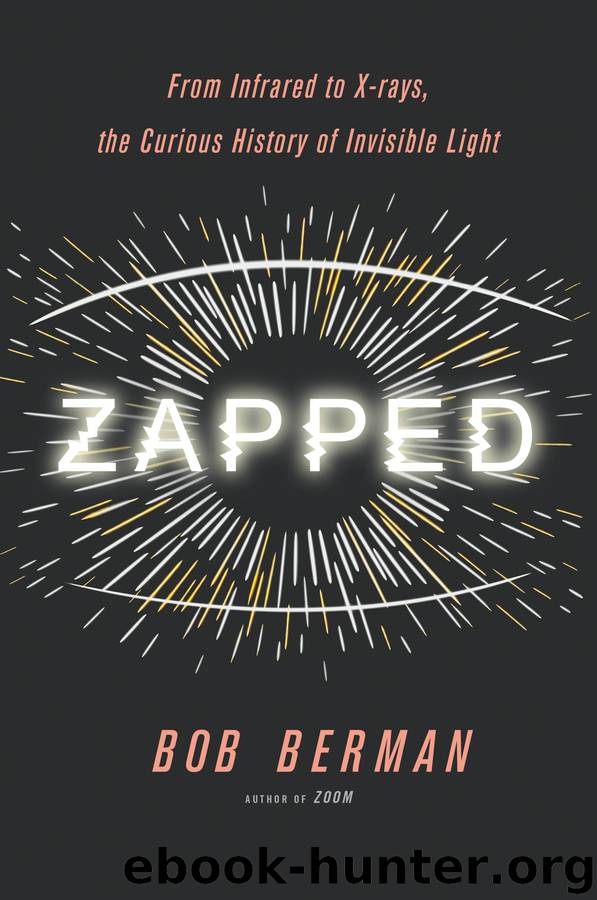Zapped by Bob Berman

Author:Bob Berman
Language: eng
Format: epub
Tags: Science / Physics / Optics & Light
Publisher: Little, Brown and Company
Published: 2017-08-07T16:00:00+00:00
CHAPTER 15
What’s in Your Basement?
Did you know that a single whole-body CT scan often delivers more radiation than was received by Hiroshima survivors a mile from ground zero? Or that living across the street from a nuclear power plant for a full year gives you less radiation than eating a single banana? (That fruit contains a tiny bit of radioactive potassium-40, the main source of radioactivity in our bodies. It has a half-life of 1.42 billion years, so you might as well learn to like it.)
What is radiation? And how much of it is too much? For the vast majority of us, this issue is utterly bewildering. In our exploration of unseen rays and invisible hazards, we need a serious “time-out” to understand radiation.
Few terms are more misunderstood. Since the middle of the nineteenth century and the work of Faraday and Maxwell, all forms of light have been termed electromagnetic radiation. By this definition, a candle emits radiation, as do a night-light and the moon. Of course, such radiation is totally harmless.
By the final years of the nineteenth century, physicists began to discover invisible emanations in their labs and, as it turned out, throughout nature. Radium darkened photographic paper just the way X-rays did. This, too, was radiation, but an unknown kind. Was radium emitting tiny particles smaller than atoms? Or, instead, was it emitting unknown varieties of light rays? Whatever its nature, scientists wondered whether it was harmful or benign. Could it even be salutary? No one knew.
Soon all invisible emissions—whether particles or rays—that proved capable of affecting the body were labeled radiation, even though everyone knew that the word would also continue to be applied to harmless emissions such as those from starlight and fireflies. In short, the word radiation came to have at least two different meanings—which, confusingly enough, is still the case today.
So in this chapter, from this point on, unless I say “electromagnetic radiation,” which just means some form of light, visible or invisible, my use of the word radiation will follow the most common usage and refer only to potentially dangerous emissions. Radiation can take the form of a submicroscopically tiny, high-speed, bulletlike piece of an atom, such as a proton, or a bit of light whose waves are so short that they can damage atoms they hit and thus induce cellular changes in living organisms.
Yet even that isn’t the end of it. Electricity can kill you, yet nobody thinks of electricity as a form of radiation. No, to qualify as radiation, an emission must have the ability to fly through space or the atmosphere and not merely be transmissible through wires and such. Got all that?
Let’s try this again: for the rest of this chapter, I’ll call radiation anything invisibly tiny that doesn’t require another substance to travel through but instead flies at superhigh speeds from point A to point B and can penetrate living tissue to affect animals and people. In discussions of biological damage, the word radiation means particles or energies that can alter atoms and therefore a cell’s genes, causing birth defects and cancer.
Download
This site does not store any files on its server. We only index and link to content provided by other sites. Please contact the content providers to delete copyright contents if any and email us, we'll remove relevant links or contents immediately.
The Complete Stick Figure Physics Tutorials by Allen Sarah(7135)
Secrets of Antigravity Propulsion: Tesla, UFOs, and Classified Aerospace Technology by Ph.D. Paul A. Laviolette(4974)
Thing Explainer by Randall Munroe(3782)
The River of Consciousness by Oliver Sacks(3412)
The Order of Time by Carlo Rovelli(3072)
How To by Randall Munroe(2911)
I Live in the Future & Here's How It Works by Nick Bilton(2839)
A Brief History of Time by Stephen Hawking(2819)
What If?: Serious Scientific Answers to Absurd Hypothetical Questions by Randall Munroe(2542)
The Great Unknown by Marcus du Sautoy(2532)
Midnight in Chernobyl by Adam Higginbotham(2384)
Blockchain: Ultimate Step By Step Guide To Understanding Blockchain Technology, Bitcoin Creation, and the future of Money (Novice to Expert) by Keizer Söze(2379)
Networks: An Introduction by Newman Mark(2264)
The Meaning of it All by Richard Feynman(2213)
Easy Electronics by Charles Platt(2204)
The Tao of Physics by Fritjof Capra(2162)
Midnight in Chernobyl: The Untold Story of the World's Greatest Nuclear Disaster by Adam Higginbotham(2074)
When by Daniel H Pink(2020)
Introducing Relativity by Bruce Bassett(2015)
